
|   |

|   |
|
Weaving threads of imagination, contemplation and artistry - Anand Nandi e-mail: anandnandi30@gmail.com Photos courtesy: Mahagami October 10, 2019 Aurangabad based Mahagami Gurukul is getting known and revered for its unique ways of conceptualizing events and festivals. Led by the versatile and multi-talented Parwati Dutta who has been curating events at Mahagami since more than 23 years, the Gurukul recently presented a 2-day festival 'Gandhi Parv' to mark 150 years of Mahatma Gandhi. The tastefully designed brochure with the concept note carried detailed information about the festival and the choreographer's note. 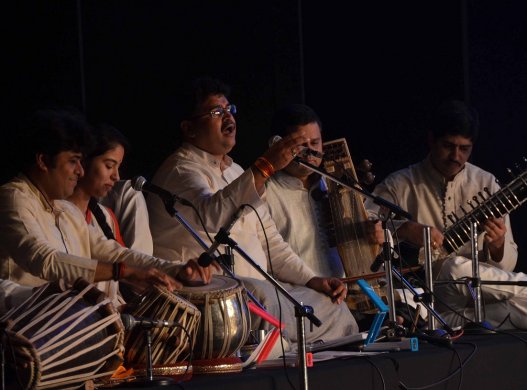 Pt Bhuvanesh Komkali 'Sadgamaya' inspired by artistic tributes to Mahatma Gandhi by Pandit Kumar Gandharva and Sayed Haider Raza was a unique way of paying obeisance to the Mahatma. Parwati Dutta teamed up with Bhuvanesh Komkali - grandson of the legendary Pandit Kumar Gandharva - to present a soulful rendition of raag Gandhi Malhar. In Kumar Gandharva's words, "I decided to create a new raga as tribute depicting the two qualities of his character that I adored and respected most; his truthfulness resulting in 'abhaya' (fearlessness) and his 'nisseem karuna' (boundless compassion). Malhar was capable enough to echo them both, hence I based the raga on that and named it 'Gandhi Malhar'." 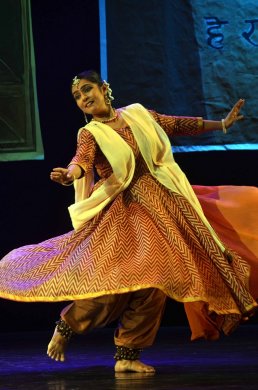 Parwati Dutta Parwati Dutta began her solo Kathak performance with an abstract invocation to the 'form' and 'formless' through a serene alaap sung by Bhuvanesh Komkali coupled with abstract movements in dance. The energy of the alaap grew subtly with pakhawaj jod-jhala culminating in silence on 'sama' with an aim to highlight the word 'dheer' - the aesthetic center of the vilambit bandish. It was interesting to observe that instead of directly starting the theka which is usual for Khayal compositions, she opted to gradually move from exploration of the phrase 'dheer' to the mukhada - 'tum ho dheer' and then the actual taal got introduced. This ushered the audience to the idea of compassion, peace and forgiveness in the most sublime and soulful way. The lyrics were in praise of Gandhiji: "Tum ho dheer, sanjeevan Bharat ke." Various rhythmic patterns and compositions brought forth the radiant aura of the Mahatma in a suggestive way. There were interesting passages where the dancers traversed the stage tracing lines, diagonals and circles, seeking to relive the artistic brilliance of Raza's paintings painted as tribute to Gandhiji. Few internalized compositions in vilambit teentaal were rendered with the mukhada as the punctuation each time. Moving to faster taal, she chose to conclude the piece with tatkaar patterns ending before sam to highlight the void on 'sama', thus signifying the idea of peace and 'dheer'. A small narrative passage on Gita Upadesh was presented where Lord Krishna explains to Arjun that, 'He whose mind is unaffected by misery or pleasure and is free from all bonds and attachments, fear and anger, is a man of steady wisdom and decisive intellect.' This was linked to the composition in drut ektaal, a reminder of Gandhiji's deep faith in universal harmony, truth, ahimsa and compassion. The words are, 'tum me sab roop'. Parwati concluded here dance offering with a Kabir bhajan, 'Suntaa hai guru gyaani'. Waves of deep rasaanubhav pervaded the auditorium as Parwati's contained abhinaya sought to resonate with eternity and the rasikas were transported to a world of eternal peace and truth. Bhuvanesh was in the best of his element while singing the Kabir bhajan which concluded with a verse in Pali on the journey and path of the enlightened souls (buddhas). 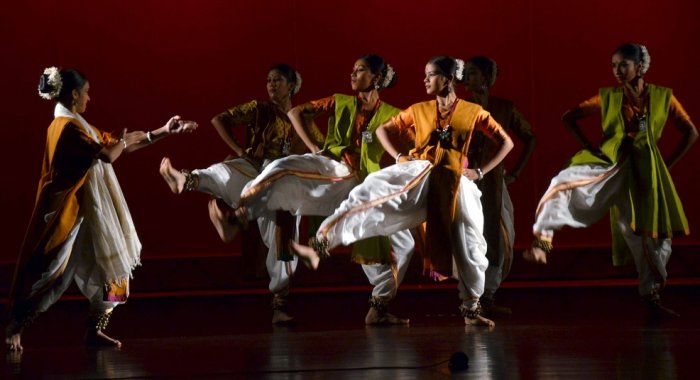 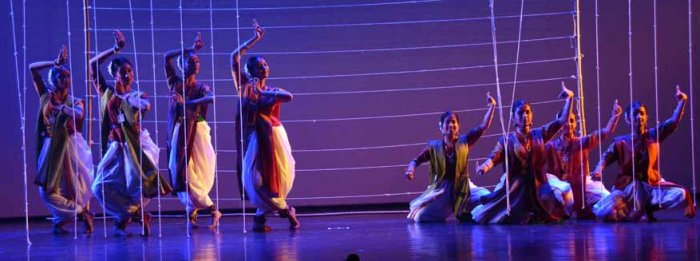 The following day brought newer surprises for the rasikas as the Mahagami Ensemble comprising well-trained dancers of Kathak and Odissi presented 'Sutratman: luminous threads of Gandhi.' This was a dance tribute to the 'luminous soul and enlightened mind that showed the path of peace and illuminated our journeys towards weaving the threads of compassion, forgiveness, truth, faith and divinity', as narrated by Dutta in the beginning of the production. Conceptualized and choreographed by Parwati Dutta, Sutratman, meaning 'a soul which passes like a thread through the universe' was an imaginative journey exploring and re-interpreting the deeper meaning of thread (sutra) and a hand-woven fabric. Playing with the idea of sutra, it came as a surprise to see the Sutradhaar descending on the stage by hanging on a sutra (rope)! Suggestive use of circular movements to indicate a charkha, the flow of time and eternity immediately introduced the beholder to a multi-layered journey. Going back in time, scenes of Gandhiji's childhood and education, humiliation in South Africa, contemplation of the situation were briefly shown as a base for the onward creative exploration of Gandhi's persona. Parwati picked Buddha, Henry Salt, Leo Tolstoy and Mahatma Phule, the four major inspirations of Gandhiji, and wove their ideologies into a richly imaginative Jog Pallavi. While Pallavi in Odissi tradition is said to evoke the idea of blossoming or unfolding, this Pallavi in Jog, a rare raag for Odissi, was well suited to the theme. Weaving movements, imageries, fluid alaap and floor designs through various steps in chauka and tribhang, the pallavi musically composed by Parwati had a touch of class, classicism and originality. Raag Jog emanated an aura of mystery, mysticism and internalized power. What was interesting in the entire production was the non-narrative and non-linear approach to an otherwise linear narrative on a great man. It was brilliant to see how Gandhiji's 11 promises - Satya, Ahimsa, Asteya (non-stealing), Aparigraha (non-possession), Brahmacharya, Sharira-shram, Aaswad (no temptations for taste), Abhaya (fearlessness), Sarva-dharma-samaanatva, Swadeshi, Asprishyataa-nirmoolan were artistically treated through a time-cycle of 11matras. The entire stage was treated as a loom with warp and weft of threads along the space. Weaving along space and time through rhythm, melody and movement transported the beholder to the idea of genesis of a fabric, spinning of charkha and to the evolution of life in the womb, metaphorically indicating the genesis of life and significance of good deeds. In few sequences, the production Sutratman reflected flashes of intellectual mastery, one such being a scene symbolically depicting the journey of a thread in a loom. Utterances of a set of Sanskrit alphabets when recited left to right became Ram stuti; when uttered right to left was Krishna stuti, symbolically depicting the idea of weaving through sounds and syllables ultimately weaving a fabric of bhakti. A Marathi song 'Dhaga dhaga akhanda vinuyaa...' was an awakening to weave a fabric with the threads of universal harmony, love and unity. In tune with the spirit of Gandhi, Parwati took us towards the more intense and inevitable juncture with a pinch of detachment. Dwelling along fast-paced paran of Kathak with cloth and threads in hand and ultimately spinning those in the air with abandon, she introduced us to the vulnerability of a cloth and also, uncertainty of life. Both are created with great care and devotion over time, but their dissolution and shredding is inevitable. 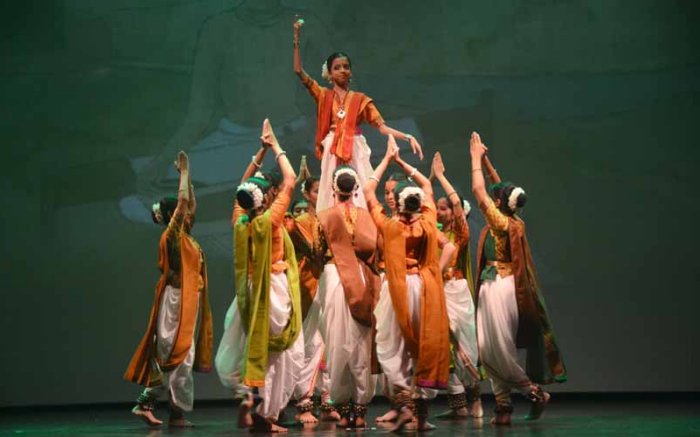 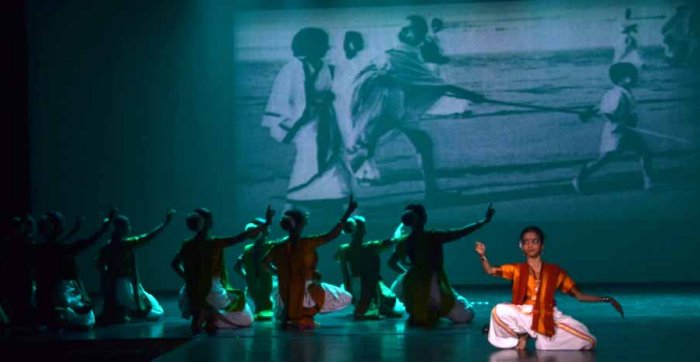 A suggestive rendition to Kabir's 'Jhini jhini bini chadariyaa...' was a delight to watch. The divine spins the eternal charkha and weaves a garment (shareera - body) for each one of us. Also narrated in Geeta Upadesh - Just as we procure new fabric when the older ones are torn, similarly the soul acquires a new body in every birth. Gandhi was a mortal body but an eternal soul whose fabric / human form was made of luminous threads, each emerging from profound realizations, discoveries and revelations. The journey of Sutratman pauses at this point with humming of "Vaishnav jana to tene kahiye ..." and a heartfelt tribute to the Mahatma. The standing ovation that echoed for next few minutes were testimony to the deep research, conceptualization and sensitive choreography of dancer Parwati Dutta, a Gandhian in her own right. Both Sadgamaya and Sutratman richly deserve many more opportunities to be presented in global platforms not just for their innovative ways of portraying Gandhiji but also to experience the sublime yet intense and indirect treatment of a subject as direct as Mahatma Gandhi. |